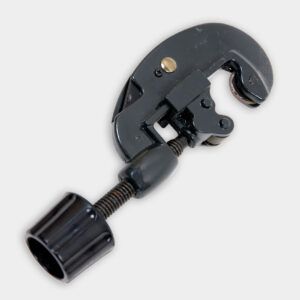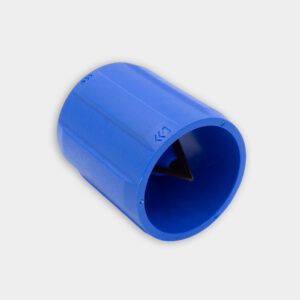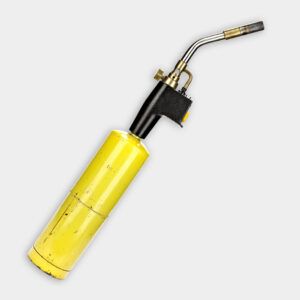We may be compensated if you purchase through links on our website. Our team is committed to delivering honest, objective, and independent reviews on home products and services.
Cutting and soldering copper pipe is a fundamental skill for many plumbing projects. Whether you’re repairing a leaky pipe or installing a new fixture, mastering these techniques can save you time and money. This Old House plumbing and heating expert Richard Trethewey demonstrates the essential steps for properly cutting and soldering copper pipe, so you can make sure you get a watertight seal that will stand up over time.
Tools and Materials Needed for Cutting and Soldering
Before you start, get all your tools and materials ready. That way, once you start working you won’t have to stop in the middle to find something. Here’s what you’ll need:
- Tubing cutter
- Reaming tool
- Emery cloth
- Pipe brush
- Flux
- Propane torch
- Solder
- Thick cotton cloth
Cutting Copper Pipe
The first step in working with copper pipe is making a clean, precise cut. This ensures a proper fit and seal when joining pipes and fittings. Here’s how to cut copper pipe effectively.
Using a Tubing Cutter
- Place the tubing cutter around the pipe at the desired cutting point.
- Tighten the cutter’s knob to apply pressure to the pipe.
- Rotate the cutter around the pipe, gradually tightening the knob after each rotation.
- Continue this process until the pipe is completely cut through.
Smoothing the Cut
After cutting, you need to smooth the pipe end to make sure water can flow smoothly through the pipe and that you get a good join between the ends. Richard Trethewey demonstrates two methods for smoothing the cut:
- Use the reaming tool built into the tubing cutter to remove any burrs or deformations.
- For more frequent copper work, use a dedicated reaming tool for a smoother finish.
Preparing the Copper Pipe and Fitting
Proper preparation of both the pipe and fitting is crucial for a strong, leak-free solder joint. This process involves cleaning and applying flux to ensure the solder adheres correctly.
Cleaning the Pipe and Fitting
- Use emery cloth to clean the outside of the pipe end, removing any oxidation or debris.
- Clean the inside of the fitting using either a rolled-up piece of emery cloth or a pipe brush designed for this purpose.
Applying Flux
- Use a flux brush to apply a thin, even layer of flux to the outside of the pipe end.
- Apply flux to the inside of the fitting as well.
- Ensure complete coverage, as the solder will not bond properly without flux.
Soldering the Pipe Joint
With the pipe and fitting prepared, it’s time to solder the joint. This process requires careful attention to heat application and solder flow.
Heating the Joint
- Assemble the pipe and fitting, ensuring they’re fully seated.
- Use a propane torch to apply heat to one side of the fitting.
- Move the flame around the joint to ensure even heating.
- Watch for the flux to begin bubbling, indicating the joint is hot enough for soldering.
Applying Solder
- Once the flux bubbles, touch the solder to the joint opposite the flame.
- The heat should draw the solder into the joint.
- Continue applying solder until it appears around the entire circumference of the joint.
- Remove the heat once the joint is fully soldered.
Finishing the Joint
- Allow the joint to cool for a few moments.
- Use a thick cotton cloth to wipe away any excess solder while it’s still warm.
- Inspect the joint for complete solder coverage and a smooth appearance.
Tips for Successful Soldering
To make sure you get consistent, high-quality solder joints, keep these tips in mind:
- Always clean and flux both the pipe and fitting before soldering.
- Apply heat evenly to avoid creating weak spots in the joint.
- Use the appropriate amount of solder – too little won’t create a proper seal, while too much can clog the pipe.
- Practice on scrap pieces of pipe before tackling your actual project.
Safety Considerations When Soldering Pipe
Working with open flames and hot metal requires careful attention to safety. Follow these precautions:
- Wear safety glasses to protect your eyes from solder splatter.
- Use heat-resistant gloves to prevent burns.
- Work in a well-ventilated area to avoid inhaling fumes.
- Keep a fire extinguisher nearby in case of emergencies.
- Allow soldered joints to cool completely before handling or testing.
Common Mistakes to Avoid When Soldering Copper Pipe
Even experienced DIYers can make mistakes when soldering copper pipe. Here are some common pitfalls to watch out for:
- Failing to clean the pipe and fitting thoroughly
- Applying too much or too little flux
- Overheating the joint, which can damage the pipe or fitting
- Moving the pipe before the solder has fully cooled and solidified
- Forgetting to test the joint for leaks after completion
Additional Techniques and Considerations for Soldering Copper Pipe
Soldering copper pipe is more than just the basic steps of cutting, cleaning, and heating. Consider these additional techniques and practices that can help improve your plumbing projects for a professional finish.
Selecting the Right Solder
For a successful joint, you need to choose the right solder. Lead-free solder is generally recommended for plumbing applications, as it is safe for potable water systems. Always check to make sure that the solder you select matches the requirements for your specific project.
Proper Ventilation
Working in a well-ventilated area helps you avoid inhaling harmful fumes from the flux and solder. If you’re working indoors, open windows and doors to allow fresh air to circulate. Using a fan to direct fumes away from your workspace can also help improve air quality.
Joining Different Pipe Materials
Sometimes, you may need to join copper pipe with galvanized steel, PVC, or other pipe materials. Each material requires specific connectors and soldering techniques. Using the appropriate adapters and following manufacturer guidelines will give you a secure connection.
Pipe Maintenance and Inspections
In order to make sure your plumbing stands up to long-term use, it’s important to perform regular maintenance and inspections. Even the best solder joints can degrade over time due to environmental factors and water quality.
Periodic Checks
Inspect your soldered joints periodically for signs of copper corrosion, leaks, or weakening. Early detection can prevent significant damage and costly repairs.
Professional Inspections
While DIY inspections are beneficial, having a professional plumber inspect your work periodically can give you better peace of mind. Professionals can identify potential issues that might not be immediately apparent to an untrained eye.
Repairing Soldered Joints
Occasionally, you may need to repair or replace soldered joints. Knowing how to address these issues can save you time and prevent bigger problems that might require professional assistance.
Desoldering a Joint
Desoldering involves heating the joint until the solder melts, allowing you to separate the pipe and fitting. Using a propane torch, heat the joint evenly and use pliers to gently pull the pieces apart. Be cautious of hot surfaces and molten solder during this process.
Re-soldering a Joint
After desoldering, clean the pipe and fitting thoroughly before reapplying flux and soldering the joint again. Ensure that both parts are free of old solder and oxidation to achieve a reliable bond.



